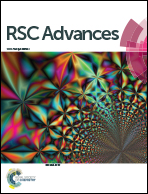A simple ‘in situ’ co-precipitation method for the preparation of multifunctional CoFe2O4–reduced graphene oxide nanocomposites: excellent microwave absorber and highly efficient magnetically separable recyclable photocatalyst for dye degradation†
Abstract
Here, an ‘in situ’ co-precipitation reaction method has been reported for the preparation of CoFe2O4–RGO (CF–RGO) nanocomposites. To the best of our knowledge, this is the first time a simple synthetic method is reported for the preparation of CoFe2O4–RGO nanocomposites where a hydrothermal technique was not used. The novelty of this technique lies in its simplicity, cost-effectiveness, and the capability of large scale production of CoFe2O4–RGO nanocomposites. The synthesized CoFe2O4–RGO nanocomposites possess excellent microwave absorbing properties as well as high photocatalytic activity towards the degradation of various dyes under visible light irradiation. 85CF–15RGO (85 wt% CF and 15 wt% RGO) showed excellent microwave absorption properties with a Reflection Loss (RL) of −31.31 dB (∼99.94% absorption) at 9.05 GHz with an 8.2–10.92 GHz effective band width range. To the best of our knowledge 85CF–15RGO nanocomposite exhibited comparable and even superior microwave absorption properties in the X-band region than most of the ferrite based composites. 75CF–25RGO (75 wt% CF and 25 wt% RGO) acted as a very good magnetically separable photocatalyst for the degradation of various synthetic dyes (such as methyl orange, methylene blue, rhodamine B and a mixture of these dyes) under visible light irradiation emitted from a 100 W reading lamp. Moreover, CoFe2O4–RGO catalyst also showed easy magnetic separation with high reusability. The photocatalytic activity of 75CF–25RGO was found to be comparable and in some cases better than the various reported RGO–ferrite composites. The simple method of preparation and multifunctional character make CF–RGO nanocomposites attractive materials for application in the area of photocatalysis as well as microwave absorption.


 Please wait while we load your content...
Please wait while we load your content...